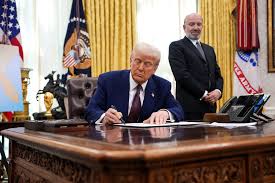Former President Donald Trump is advancing a bold trade strategy known as the “Fair and Reciprocal Plan,” which could introduce new tariffs on countries imposing duties on U.S. imports. While the plan aims to address long-standing trade imbalances, it has sparked concerns about a potential global trade war.
Key Aspects of the Plan
Reciprocal Tariffs
Trump has proposed that the U.S. will charge countries the “exact same tax or tariff” that they impose on American goods. To achieve this, he has directed his economic team to formulate a plan for implementing these tariffs.
“Fair and Reciprocal Plan” Memorandum
A Presidential Memorandum has been signed to develop a strategy that ensures fairness in U.S. trade relationships. The primary objectives include prioritizing American workers, enhancing competitiveness, reducing the trade deficit, and strengthening economic and national security.
Broad Application of Tariffs
Unlike previous trade policies that included exemptions for allies, this plan may be universally applied to all trading partners, regardless of their diplomatic ties with the U.S.
Implementation Timeline
Government agencies have been given until April 1, 2025, to conduct assessments and offer recommendations regarding the execution of the plan.
Legal Justification
Trump may rely on existing statutes to impose these tariffs, including:
- Section 122 of the Trade Act of 1974
- Section 338 of the Tariff Act of 1930
- The International Emergency Economic Powers Act (IEEPA)
These legal provisions grant the President the authority to enforce trade restrictions in response to unfair practices by foreign nations.
Potential Economic Impact
The proposal could have significant repercussions, particularly for developing nations such as India, Brazil, Vietnam, and African countries, where tariff disparities are substantial. Economists warn that American consumers may ultimately bear the financial burden through increased prices on imported goods.
Global Response and Future Discussions
The announcement has already ignited discussions on trade policies worldwide. Trump has stated that he is open to reducing tariffs, provided that other nations follow suit and eliminate their own trade barriers.
As the April 2025 deadline approaches, the global economic community will closely watch how this policy unfolds. Will it successfully level the playing field, or will it escalate trade tensions further? Only time will tell.
